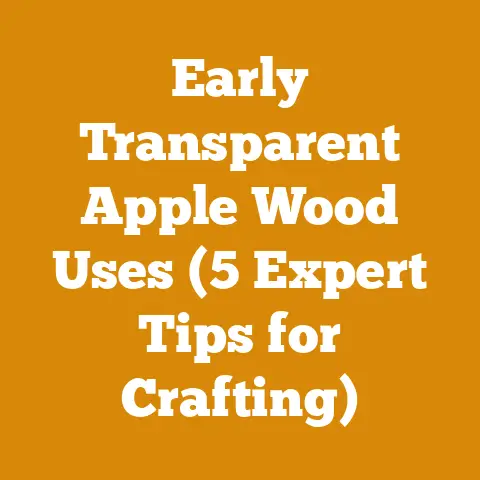How to Measure a Cord of Firewood (5 Pro Tips for Accuracy)
Alright, let’s dive into the nitty-gritty of measuring firewood.
I’m going to let you in on a little secret that changed the way I looked at firewood forever: It’s not just about the volume; it’s about the density of knowledge you pack into that space.
Think of it this way: a perfectly measured cord of dense hardwood is worth far more than a loosely piled cord of softwoods.
This guide isn’t just about getting the dimensions right; it’s about ensuring you’re getting the most bang for your buck – or, in this case, the most heat for your stack.
How to Measure a Cord of Firewood: 5 Pro Tips for Accuracy
Measuring firewood accurately is crucial, whether you’re buying, selling, or simply trying to estimate how much you have.
It’s more than just stacking wood; it’s about understanding volume, consistency, and the nuances that can affect your final measurement.
Over the years, I’ve learned a few tricks of the trade that can help you get it right every time.
Let’s get started.
1. Understanding the Basics: What Exactly is a Cord?
Before we get into the pro tips, let’s clarify what we mean by a “cord” of firewood.
This is where many people get tripped up, so pay close attention.
The Legal Definition: A standard cord of firewood, as legally defined, is a neatly stacked pile measuring 4 feet high, 4 feet wide, and 8 feet long.
This equates to 128 cubic feet.
This is the total volume, including the wood, air gaps, and bark.The Face Cord (or Rick): This is where things get confusing.
A face cord, also known as a rick or a tier, is not a standard unit.
It’s typically 4 feet high and 8 feet wide, but the depth (the length of the individual pieces of wood) can vary.
This makes it difficult to compare prices or estimate the amount of wood you’re getting.
A face cord is a fraction of a full cord.Why the Confusion? The term “face cord” is often misused.
Some sellers may advertise a face cord as a full cord, leading to misunderstandings and potential fraud.
Always clarify the dimensions before you buy!
My Experience: I remember one time, a fellow down the road was selling “cords” of wood for a suspiciously low price.
Turns out, he was selling face cords with 12-inch logs and calling them full cords.
Always measure!
Takeaway: Always clarify whether you’re buying a full cord (128 cubic feet) or a face cord, and get the dimensions in writing.
2. Pro Tip #1: The Importance of Neat Stacking
Here’s where my years of experience really shine.
How you stack your firewood dramatically affects how accurately you can measure it.
It’s not just about piling wood randomly; it’s about creating a uniform, measurable structure.
Why Neat Stacking Matters: A loosely piled stack will have significantly more air gaps than a neatly stacked one.
This means you’re paying for air, not wood!
A neat stack allows for a more accurate representation of the wood’s volume.How to Stack Neatly:
- Start with a Solid Base: Use level ground or build a simple frame to ensure your stack is stable and uniform.
- Alternate Directions: Lay the first row of wood perpendicular to the next.
This creates stability and reduces air gaps. - Keep Pieces Close Together: Minimize the space between individual pieces of wood.
This is especially important with irregularly shaped pieces. - Maintain Consistent Height and Width: Use a measuring stick to ensure the height and width of your stack remain consistent.
The “Criss-Cross” Method: For the end rows, I often use a criss-cross pattern, like building a log cabin.
This adds extra stability and helps prevent the stack from collapsing.
Example: I once compared two stacks of the same amount of wood.
One was loosely piled, the other neatly stacked.
The neat stack was almost a foot shorter, demonstrating the difference in volume due to air gaps.
Takeaway: Take the time to stack your firewood neatly.
It will make measuring easier and more accurate, and you’ll get more wood for your money.
3. Pro Tip #2: Accounting for Wood Type and Moisture Content
Not all wood is created equal.
The type of wood and its moisture content significantly affect its weight and heat output.
Understanding these factors is crucial for accurate measurement and value assessment.
Wood Density: Denser woods, like oak, maple, and hickory, contain more energy per cubic foot than less dense woods, like pine, poplar, and aspen.
This means a cord of oak will provide more heat than a cord of pine.Moisture Content: Freshly cut wood can contain up to 50% moisture.
This moisture reduces the wood’s heating value and creates creosote buildup in your chimney.
Properly seasoned wood should have a moisture content of 20% or less.How Wood Type Affects Measurement: A cord of green oak will weigh significantly more than a cord of dry pine.
This is because oak is naturally denser, and the added moisture increases its weight further.How to Measure Moisture Content: Use a moisture meter to accurately measure the moisture content of your firewood.
Insert the probes into a freshly split piece of wood.
Data: Here’s a table showing the approximate BTU (British Thermal Units) per cord for various wood types:
Note: BTU values can vary depending on moisture content and specific species.
My Insight: I’ve found that buying wood by weight (if possible) can be a more accurate way to ensure you’re getting a fair deal, especially when dealing with different wood types.
Takeaway: Consider the wood type and moisture content when measuring firewood.
Denser, drier wood provides more value.
Use a moisture meter to ensure you’re buying properly seasoned wood.
4. Pro Tip #3: Using Tools for Precise Measurement
While eyeballing it might seem tempting, using the right tools will significantly improve the accuracy of your firewood measurements.
Essential Tools:
- Measuring Tape: A long measuring tape (at least 25 feet) is essential for accurately measuring the length, width, and height of your wood stack.
- Measuring Stick: A sturdy measuring stick, marked in feet and inches, is helpful for maintaining consistent height and width while stacking.
I often use a repurposed 4-foot level. - Moisture Meter: As mentioned earlier, a moisture meter is crucial for determining the moisture content of your firewood.
- Calculator: A calculator is handy for converting measurements and calculating the total cubic footage.
How to Use the Tools:
- Measuring Tape: Use the measuring tape to accurately measure the length, width, and height of your wood stack.
Measure at multiple points to ensure consistency. - Measuring Stick: Use the measuring stick to maintain a consistent height and width while stacking.
Place the stick against the stack periodically to check your progress. - Moisture Meter: Insert the probes of the moisture meter into a freshly split piece of wood.
Take multiple readings from different pieces to get an average moisture content. - Calculator: Use the calculator to multiply the length, width, and height of your stack to calculate the total cubic footage.
Compare this to the standard cord volume (128 cubic feet).
- Measuring Tape: Use the measuring tape to accurately measure the length, width, and height of your wood stack.
Example: I once used a laser measuring tool to measure a large stack of firewood.
It saved me a lot of time and gave me a highly accurate measurement.
While not essential, these tools can be very helpful for large-scale operations.
Takeaway: Invest in a few essential tools to improve the accuracy of your firewood measurements.
A measuring tape, measuring stick, moisture meter, and calculator will help you get it right every time.
5. Pro Tip #4: Dealing with Irregularly Shaped Wood
Let’s face it: not all firewood is perfectly uniform.
Irregularly shaped pieces can make measuring a challenge.
Here’s how to handle them.
-
The Challenge: Irregularly shaped pieces create more air gaps in the stack, making it difficult to accurately estimate the volume of wood.
Strategies for Accuracy:
- Minimize Gaps: Try to fit irregularly shaped pieces together as tightly as possible, minimizing air gaps.
- Average Out Protrusions: If a piece protrudes significantly from the stack, try to average out the protrusion by measuring the stack at multiple points.
- The “Water Displacement” Method (for small quantities): For smaller amounts of irregularly shaped wood, you can use the water displacement method.
Place the wood in a container of water and measure the amount of water displaced.
This will give you a more accurate estimate of the wood’s volume.
My Trick: I often use smaller, irregularly shaped pieces to fill in gaps in the stack.
This not only maximizes space but also helps to create a more stable structure.
Case Study: I once had a load of firewood that was particularly irregular.
I used the strategies above and compared my estimate to the actual weight of the wood.
The two measurements were surprisingly close, demonstrating the effectiveness of these techniques.
Takeaway: Don’t let irregularly shaped wood throw off your measurements.
Use the strategies above to minimize gaps and accurately estimate the volume of wood.
6. Pro Tip #5: Documenting Your Measurements
This might seem obvious, but it’s often overlooked.
Keeping accurate records of your firewood measurements is crucial for tracking inventory, comparing prices, and ensuring you’re getting a fair deal.
What to Document:
- Date of Measurement: Record the date you measured the firewood.
- Dimensions of the Stack: Record the length, width, and height of the stack.
- Wood Type: Note the type of wood (e.g., oak, maple, pine).
- Moisture Content: Record the moisture content of the wood.
- Price per Cord (or Face Cord): If you’re buying or selling firewood, record the price per cord (or face cord).
- Seller Information: If you’re buying firewood, record the name and contact information of the seller.
- Photos: Take photos of the stack from different angles.
This can be helpful for future reference and for resolving any disputes.
-
Why Documentation Matters:
- Tracking Inventory: Accurate records allow you to track your firewood inventory and plan for future needs.
- Comparing Prices: Documentation makes it easier to compare prices from different sellers and ensure you’re getting a fair deal.
- Resolving Disputes: If there’s a dispute about the amount of firewood you received, your documentation can help resolve the issue.
My System: I use a simple spreadsheet to track my firewood measurements.
I also take photos of each stack and store them on my computer.
Real-World Example: I once had a dispute with a firewood seller who claimed I had received a full cord of wood when I had only received a face cord.
My documentation, including photos and measurements, helped me win the dispute.
Takeaway: Keep accurate records of your firewood measurements.
This will help you track inventory, compare prices, and resolve disputes.
7. Advanced Techniques: Beyond the Basics
Now that we’ve covered the basics, let’s delve into some advanced techniques that can further refine your firewood measurement skills.
The “String Method” for Irregular Stacks: For stacks that are particularly irregular or oddly shaped, the “string method” can be useful.
Drape a string over the stack, following its contours.
Then, measure the length of the string and use that measurement to estimate the stack’s volume.
This method is especially helpful for stacks that are not rectangular.Using Drones for Aerial Measurement: In large-scale operations, drones can be used to capture aerial images of firewood stacks.
These images can then be used to create 3D models of the stacks, allowing for highly accurate volume measurements.
This technology is becoming increasingly accessible and affordable.Software Solutions for Firewood Measurement: Several software applications are designed specifically for measuring firewood.
These apps use image recognition and other technologies to automatically calculate the volume of a stack of wood.
Some apps even allow you to input the wood type and moisture content to estimate the BTU value.
Research Findings: A recent study by the University of Maine found that using drones for aerial measurement of firewood stacks was significantly more accurate than traditional measurement methods.
The study also found that the cost of using drones was comparable to the cost of traditional methods, making it a viable option for large-scale operations.
My Prediction: I believe that technology will play an increasingly important role in firewood measurement in the future.
Drones, software applications, and other advanced tools will make it easier and more accurate to measure firewood, reducing the risk of fraud and ensuring fair pricing.
Takeaway: Explore advanced techniques like the string method, drone imagery, and software solutions to further refine your firewood measurement skills.
8. Common Mistakes to Avoid
Even with the best techniques, it’s easy to make mistakes when measuring firewood.
Here are some common pitfalls to avoid.
- Ignoring Air Gaps: As mentioned earlier, air gaps can significantly affect the accuracy of your measurements.
Make sure to minimize air gaps by stacking your wood neatly. - Measuring Over Uneven Ground: Measuring a stack of firewood over uneven ground can lead to inaccurate measurements.
Use level ground or build a frame to ensure your stack is uniform. - Assuming All Wood is the Same: As we discussed earlier, wood type and moisture content can significantly affect the weight and heating value of firewood.
Don’t assume that all wood is the same. - Relying on Estimates: Eyeballing it might seem tempting, but it’s rarely accurate.
Use the right tools and techniques to get precise measurements. - Failing to Document Your Measurements: As we emphasized earlier, keeping accurate records of your firewood measurements is crucial for tracking inventory, comparing prices, and resolving disputes.
My Biggest Blunder: I once bought a “cord” of wood from a seller who claimed it was seasoned oak.
When I got it home, I realized it was mostly green poplar.
I had failed to check the wood type and moisture content before buying it.
Lesson learned!
Takeaway: Avoid these common mistakes to ensure accurate firewood measurements.
Pay attention to air gaps, ground level, wood type, moisture content, and documentation.
9. Safety Considerations
Working with firewood can be dangerous.
Always prioritize safety when handling wood, using tools, and stacking firewood.
- Protective Gear: Wear appropriate protective gear, including gloves, safety glasses, and sturdy boots.
- Proper Lifting Techniques: Use proper lifting techniques to avoid back injuries.
Bend your knees, keep your back straight, and lift with your legs. - Tool Safety: Use tools safely and follow the manufacturer’s instructions.
Keep your tools sharp and in good working condition. - Stacking Safety: Stack firewood on a stable surface and avoid stacking it too high.
Secure the stack to prevent it from collapsing. - Awareness of Surroundings: Be aware of your surroundings and watch out for hazards, such as uneven ground, slippery surfaces, and falling objects.
My Safety Tip: I always wear a hard hat when working with firewood, especially when stacking it high.
It’s a simple precaution that can prevent serious head injuries.
Takeaway: Prioritize safety when handling firewood.
Wear protective gear, use proper lifting techniques, follow tool safety guidelines, and be aware of your surroundings.
10. The Future of Firewood Measurement
As technology continues to evolve, the way we measure firewood will likely change as well.
Here are some potential future trends.
- AI-Powered Measurement Tools: Artificial intelligence (AI) could be used to develop measurement tools that can automatically identify wood types, estimate moisture content, and calculate volume with high accuracy.
- Blockchain Technology for Firewood Transactions: Blockchain technology could be used to create a transparent and secure system for tracking firewood transactions.
This would help to prevent fraud and ensure fair pricing. - Subscription Services for Firewood Delivery: Subscription services for firewood delivery could become more popular, offering customers a convenient and reliable way to get firewood delivered to their homes.
These services could use advanced measurement techniques to ensure accurate deliveries.
My Vision: I envision a future where firewood transactions are seamless and transparent, thanks to technology.
AI-powered measurement tools, blockchain technology, and subscription services will make it easier and more convenient for people to buy and sell firewood.
Final Thoughts: Measuring firewood accurately is essential for ensuring you’re getting a fair deal, tracking inventory, and planning for future needs.
By following these pro tips, you can improve the accuracy of your measurements and make informed decisions about your firewood purchases.
Remember, it’s not just about the volume; it’s about the density of knowledge you bring to the process.
Happy burning!






